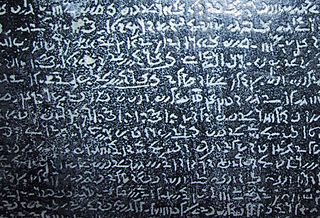
The Rosetta Stone is a granodiorite stele discovered in 1799 which is inscribed with three versions of a decree issued in Memphis, Egypt in 196 BC during the Ptolemaic dynasty on behalf of King Ptolemy V Epiphanes. The top and middle texts are in Ancient Egyptian using hieroglyphic and Demotic scripts respectively, while the bottom is in Ancient Greek. The decree has only minor differences among the three versions, so the Rosetta Stone became key to deciphering Egyptian hieroglyphs, thereby opening a window into ancient Egyptian history.

The Egyptian language was an Afro-Asiatic language spoken in ancient Egypt. Its attestation stretches over an extraordinarily long time, from the Old Egyptian stage. Its earliest known complete written sentence has been dated to about 2690 BC, which makes it one of the oldest recorded languages known, along with Sumerian.

Coptic or Coptic Egyptian, is the latest stage of the Egyptian language, a northern Afro-Asiatic language spoken in Egypt until at least the 17th century. In the 2nd century BCE, Egyptian began to be written in the Coptic alphabet, which is an adaptation of the Greek alphabet with the addition of six or seven signs from the Demotic Egyptian to compensate the absence of the Afro-Asiatic sounds that the Greek language did not have.

Egyptian hieroglyphs were the formal writing system used in Ancient Egypt. Hieroglyphs combined logographic, syllabic and alphabetic elements, with a total of some 1,000 distinct characters. Cursive hieroglyphs were used for religious literature on papyrus and wood. The later hieratic and demotic Egyptian scripts were derived from hieroglyphic writing, as was the Proto-Sinaitic script that later evolved into the Phoenician alphabet. Through the Phoenician alphabet's major child systems, the Greek and Aramaic scripts, the Egyptian hieroglyphic script is ancestral to the majority of scripts in modern use, most prominently the Latin and Cyrillic scripts and the Arabic script and Brahmic family of scripts.

Jean-François Champollion, also known as Champollion le jeune, was a French scholar, philologist and orientalist, known primarily as the decipherer of Egyptian hieroglyphs and a founding figure in the field of Egyptology. A child prodigy in philology, he gave his first public paper on the decipherment of Demotic in 1806, and already as a young man held many posts of honor in scientific circles, and spoke Coptic and Arabic fluently. During the early 19th-century, French culture experienced a period of 'Egyptomania', brought on by Napoleon's discoveries in Egypt during his campaign there (1798–1801) which also brought to light the trilingual Rosetta Stone. Scholars debated the age of Egyptian civilization and the function and nature of hieroglyphic script, which language if any it recorded, and the degree to which the signs were phonetic or ideographic. Many thought that the script was only used for sacred and ritual functions, and that as such it was unlikely to be decipherable since it was tied to esoteric and philosophical ideas, and did not record historical information. The significance of Champollion's decipherment was that he showed these assumptions to be wrong, and made it possible to begin to retrieve many kinds of information recorded by the ancient Egyptians.
The Coptic alphabet is the script used for writing the Coptic language. The repertoire of glyphs is based on the Greek alphabet augmented by letters borrowed from the Egyptian Demotic and is the first alphabetic script used for the Egyptian language. There are several Coptic alphabets, as the Coptic writing system may vary greatly among the various dialects and subdialects of the Coptic language.

The Phoenician alphabet is an alphabet consisting of 22 consonant letters only, leaving vowel sounds implicit, although certain late varieties use matres lectionis for some vowels.
![Reformed Egyptian writing system in which the Book of Mormon is alleged to be written: “we have written this record […] in the characters which are called among us the reformed Egyptian” (Morm 9:32)](https://upload.wikimedia.org/wikipedia/commons/thumb/e/e5/Mormon-book.jpg/222px-Mormon-book.jpg)
The Book of Mormon, a work of scripture of the Latter Day Saint movement, describes itself as having a portion originally written in reformed Egyptian characters on plates of metal or "ore" by prophets living in the Western Hemisphere from perhaps as early as the 6th century BC until as late as the 5th century AD. Joseph Smith, the movement's founder, published the Book of Mormon in 1830 as a translation of these golden plates. Scholarly reference works on languages do not, however, acknowledge the existence of either a "reformed Egyptian" language or "reformed Egyptian" script as it has been described in Mormon belief. No archaeological, linguistic, or other evidence of the use of Egyptian writing in ancient America has been discovered.

Hieratic is a cursive writing system used for Ancient Egyptian, and the principal script used to write that language from its development in the 3rd millenium BCE until the rise of Demotic in the mid 1st millennium BCE. It was primarily written in ink with a reed pen on papyrus.

A hieroglyph was a character of the ancient Egyptian writing system. Logographic scripts that are pictographic in form in a way reminiscent of ancient Egyptian are also sometimes called "hieroglyphs". In Neoplatonism, especially during the Renaissance, a "hieroglyph" was an artistic representation of an esoteric idea, which Neoplatonists believed actual Egyptian hieroglyphs to be. The word hieroglyphics refer to a hieroglyphic script.
Modern Greek, generally referred to by speakers simply as Greek, refers collectively to the dialects of the Greek language spoken in the modern era, including the official standardized form of the languages sometimes referred to as Standard Modern Greek. The end of the Medieval Greek period and the beginning of Modern Greek is often symbolically assigned to the fall of the Byzantine Empire in 1453, even though that date marks no clear linguistic boundary and many characteristic features of the modern language arose centuries earlier, beginning around the fourth century AD.

The system of ancient Egyptian numerals was used in Ancient Egypt from around 3000 BC until the early first millennium AD. It was a system of numeration based on multiples of ten, often rounded off to the higher power, written in hieroglyphs. The Egyptians had no concept of a place-valued system such as the decimal system. The hieratic form of numerals stressed an exact finite series notation, ciphered one to one onto the Egyptian alphabet.

The Meroitic script consists of two alphasyllabaric scripts developed to write the Meroitic language at the beginning of the Meroitic Period of the Kingdom of Kush. The two scripts are Meroitic Cursive derived of Demotic Egyptian and Meroitic Hieroglyphics derived of Egyptian hieroglyphs. Meroitic Cursive is the most widely attested script, comprising ~90% of all inscriptions, and antedates, by a century or more, the earliest, surviving Meroitic hieroglyphic inscription. Greek historian Diodorus Siculus described the two scripts in his Bibliotheca historica, Book III (Africa), Chapter 4. The last known Meroitic inscription is the Meroitic Cursive inscription of the Blemmye king, Kharamadoye, from a column in the Temple of Kalabsha, which has recently been re-dated to AD 410/ 450 of the 5th century. Before the Meroitic Period, Egyptian hieroglyphs were used to write Kushite names and lexical items.
This article is an overview of the history of the Greek language.

Demotic is the ancient Egyptian script derived from northern forms of hieratic used in the Nile Delta, and the stage of the Egyptian language written in this script, following Late Egyptian and preceding Coptic. The term was first used by the Greek historian Herodotus to distinguish it from hieratic and hieroglyphic scripts. By convention, the word "Demotic" is capitalized in order to distinguish it from demotic Greek.

The writing systems used in ancient Egypt were deciphered in the early nineteenth century through the work of several European scholars, especially Jean-François Champollion and Thomas Young. Ancient Egyptian forms of writing, which included the hieroglyphic, hieratic and demotic scripts, ceased to be understood in the fourth and fifth centuries AD, as the Coptic alphabet was increasingly used in their place. Later generations' knowledge of the older scripts was based on the work of Greek and Roman authors whose understanding was faulty. It was thus widely believed that Egyptian scripts were exclusively ideographic, representing ideas rather than sounds, and even that hieroglyphs were an esoteric, mystical script rather than a means of recording a spoken language. Some attempts at decipherment by Islamic and European scholars in the Middle Ages and early modern times acknowledged the script might have a phonetic component, but perception of hieroglyphs as ideographic hampered efforts to understand them as late as the eighteenth century.

The Greek Magical Papyri is the name given by scholars to a body of papyri from Graeco-Roman Egypt, written mostly in ancient Greek, which each contain a number of magical spells, formulae, hymns, and rituals. The materials in the papyri date from the 100s BCE to the 400s CE. The manuscripts came to light through the antiquities trade, from the 1700s onward. One of the best known of these texts is the Mithras Liturgy.
In epigraphy, a bilingual is an inscription that includes the same text in two languages. Bilinguals are important for the decipherment of ancient writing systems, and for the study of ancient languages with small or repetitive corpora.

Raet (Rˁỉ.t) or Raet-Tawy (Rˁỉ.t-tȝ.wỉ) is an ancient Egyptian solar goddess, the female aspect of Ra. Her name is simply the female form of Ra's name; the longer name Raet-Tawy means "Raet of the Two Lands".

Wilhelm Spiegelberg was a German Egyptologist. He specialized in analyses of Demotic and hieratic text.






![Reformed Egyptian writing system in which the Book of Mormon is alleged to be written: “we have written this record […] in the characters which are called among us the reformed Egyptian” (Morm 9:32)](https://upload.wikimedia.org/wikipedia/commons/thumb/e/e5/Mormon-book.jpg/222px-Mormon-book.jpg)








